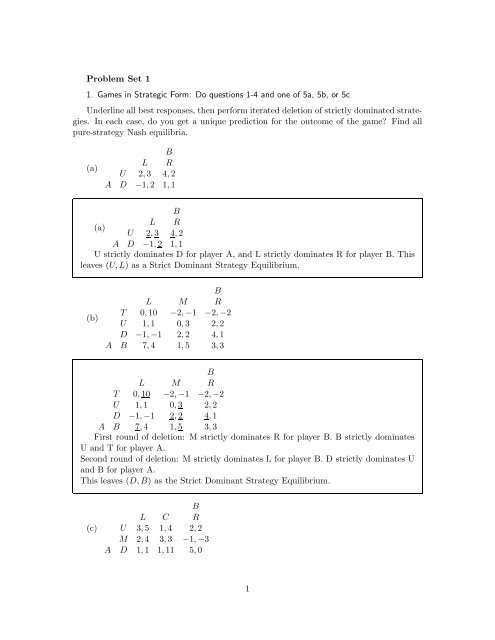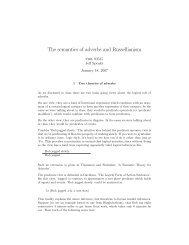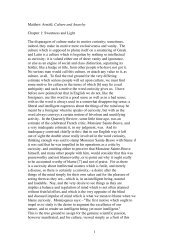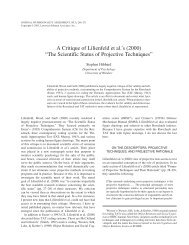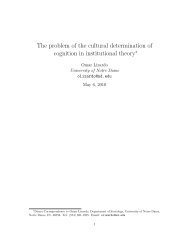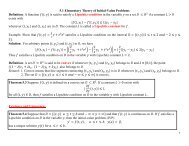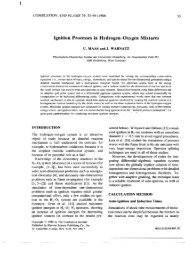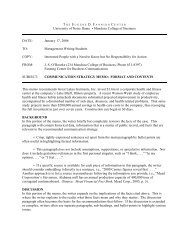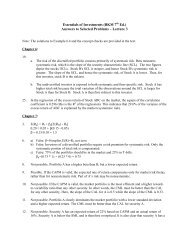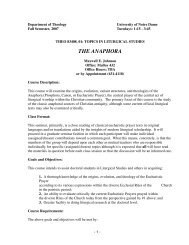Problem Set 1 1. Games in Strategic Form: Do questions 1-4 and ...
Problem Set 1 1. Games in Strategic Form: Do questions 1-4 and ...
Problem Set 1 1. Games in Strategic Form: Do questions 1-4 and ...
You also want an ePaper? Increase the reach of your titles
YUMPU automatically turns print PDFs into web optimized ePapers that Google loves.
<strong>Problem</strong> <strong>Set</strong> 1<strong>1.</strong> <strong>Games</strong> <strong>in</strong> <strong>Strategic</strong> <strong>Form</strong>: <strong>Do</strong> <strong>questions</strong> 1-4 <strong>and</strong> one of 5a, 5b, or 5cUnderl<strong>in</strong>e all best responses, then perform iterated deletion of strictly dom<strong>in</strong>ated strategies.In each case, do you get a unique prediction for the outcome of the game? F<strong>in</strong>d allpure-strategy Nash equilibria.(a)BL RU 2,3 4,2A D −1,2 1,1BL R(a)U 2,3 4,2A D −1,2 1,1U strictly dom<strong>in</strong>ates D for player A, <strong>and</strong> L strictly dom<strong>in</strong>ates R for player B. Thisleaves (U,L) as a Strict <strong>Do</strong>m<strong>in</strong>ant Strategy Equilibrium.(b)BL M RT 0,10 −2,−1 −2,−2U 1,1 0,3 2,2D −1,−1 2,2 4,1A B 7,4 1,5 3,3BL M RT 0,10 −2,−1 −2,−2U 1,1 0,3 2,2D −1,−1 2,2 4,1A B 7,4 1,5 3,3First round of deletion: M strictly dom<strong>in</strong>ates R for player B. B strictly dom<strong>in</strong>atesU <strong>and</strong> T for player A.Second round of deletion: M strictly dom<strong>in</strong>ates L for player B. D strictly dom<strong>in</strong>ates U<strong>and</strong> B for player A.This leaves (D,B) as the Strict <strong>Do</strong>m<strong>in</strong>ant Strategy Equilibrium.(c)BL C RU 3,5 1,4 2,2M 2,4 3,3 −1,−3A D 1,1 1,11 5,01
BL C RU 3,5 1,4 2,2M 2,4 3,3 −1,−3A D 1,1 1,11 5,0First round: C strictly dom<strong>in</strong>ates R for player B. M strictly dom<strong>in</strong>ates D for playerA.Second round: L strictly dom<strong>in</strong>ates C for player B. U strictly dom<strong>in</strong>ates M for playerA.This leaves (U,L) as the Strict <strong>Do</strong>m<strong>in</strong>ant Strategy Equilibrium.(d)BL C O RU 2,2 1,3 6,2 1,1T 4,3 2,2 5,1 2,−3A M 1,9 1,5 −3,2 8,8D 5,8 −1,7 2,2 1,10BL C O RU 2,2 1,3 6,2 1,1T 4,3 2,2 5,1 2,−3A M 1,9 1,5 −3,2 8,8D 5,8 −1,7 2,2 1,10Then C strictly dom<strong>in</strong>ates O for the column player. Once O is gone, T strictlydom<strong>in</strong>ates U for the row player. Then L strictly dom<strong>in</strong>ates C for the column player.Noth<strong>in</strong>g else can be deleted.You can see that no strategy profile is a mutual best response (two underl<strong>in</strong>es), sothere is no pure-strategy Nash equilibrium. This means there isn’t a weak dom<strong>in</strong>antstrategy or strict dom<strong>in</strong>ant strategy equilibrium, either.2. Write the follow<strong>in</strong>g games <strong>in</strong> strategic form. F<strong>in</strong>d all pure-strategy Nash equilibria, ifthey exist.(a). Two firms that make alcohol spend money try<strong>in</strong>g to outdo one another <strong>in</strong> advertis<strong>in</strong>g.If they both advertise, they share <strong>in</strong>dustry profits of 10,000 equally, but if one firmadvertises <strong>and</strong> the other doesn’t, the advertis<strong>in</strong>g firm gets 7,000 <strong>and</strong> the non-advertiser gets3,000. If they fail to advertise, there are fewer sales but both save on the cost of the adcampaigns, <strong>and</strong> each makes 6,000.FirmBAdvertise <strong>Do</strong>n ′ tAdvertise 5,5 7,3FirmA <strong>Do</strong>n ′ t 3,7 6,62
The Nash equilibrium is (A,A), s<strong>in</strong>ce it is a mutual best response: If either playerchanges her behavior, she gets 3 <strong>in</strong>stead of 5, mak<strong>in</strong>g her worse off. Therefore, no onehas an <strong>in</strong>centive to change.(b). Twofirmsworkclosely together <strong>and</strong>havetodecidewhethertobuyMacorW<strong>in</strong>dowscomputers. If they both buy the same platform, they coord<strong>in</strong>ate well together, <strong>and</strong> earnprofits of 3 each. If they buy different platforms, they have trouble coord<strong>in</strong>at<strong>in</strong>g, <strong>and</strong> get apayoff of 1 each.FirmBW<strong>in</strong>dows MacW<strong>in</strong>dows 3,3 1,1FirmA Mac 1,1 3,3Therearetwo pure-strategy Nashequilibria: (W,W) <strong>and</strong> (M,M). Check: No playercan change her behavior <strong>and</strong> get a higher pay-off.(c). You <strong>and</strong> an opponent both have a penny. Secretly, you choose Heads or Tails, thensimultaneously reveal the strategies you picked. If the co<strong>in</strong>s match (both heads or bothtails), you get both pennies. If they are different (one head <strong>and</strong> one tail), your opponentgets both.ThemH TH 1,−1 −1,1You T −1,1 1,−1There is NO pure-strategy Nash equilibrium. However, you should now see there’sa mixed-strategy Nash equilibrium: Play H <strong>and</strong> T each with probability 1 2 .(d). Two firms are decid<strong>in</strong>g whether or not to research a new technology. If neitherfirm researches, they both make zero. If both firms research, they get 5 each. If one firmresearches <strong>and</strong> the other doesn’t, the firm that does the research gets 10 <strong>and</strong> the firm thatdoesn’t research gets 0.2R DR 5,5 10,01 D 0,10 0,0Both firms have a dom<strong>in</strong>ant strategy to research, so the Nash equilibrium is (R,R).3. Two firms can choose any whole dollar price from 0 to 4 to charge for their product,for which they have noproduction costs. Theoverall dem<strong>and</strong> is for thegood is D(p) = 4−p;3
however, s<strong>in</strong>ce there are two firms, their prices determ<strong>in</strong>e what share of the market eachfirm gets. If the firms choose the same price, they split the market half-half. If one firmcharges a strictly higher price, it gets noth<strong>in</strong>g, while the firm that charged less serves thewhole market. More formally, if p i is firm i’s price <strong>and</strong> p j is its opponent’s price, thenprofits for firm i are ⎧⎨ (4−p i )p i ,p i < p jπ i (p i ,p j ) = (4−p⎩ i )p i /2 ,p i = p j0 ,p i > p jWrite out the strategic form <strong>and</strong> solve by iterated elim<strong>in</strong>ation of weakly dom<strong>in</strong>ated strategies.F<strong>in</strong>d all Nash equilibria. Were any Nash equilibria removed by elim<strong>in</strong>ation of weaklydom<strong>in</strong>ated strategies? Is there an economic argument to focus on any of the elim<strong>in</strong>atedstrategies that you can th<strong>in</strong>k of?If we fill out the strategic form, we get0 1 2 3 40 0,0 0,0 0,0 0,0 0,01 0,0 3/2,3/2 3,0 3,0 3,02 0,0 0,3 1,1 4,0 4,03 0,0 0,3 0,4 1/2,1/2 1,04 0,0 0,3 0,4 0,1 0,0If we do IDWDS, the follow<strong>in</strong>g happens: 0, 3 <strong>and</strong> 4 are weakly dom<strong>in</strong>ated for bothplayers, by 1 <strong>and</strong> 2. That leaves us with a strategy set of {1,2} for both players. Butthen 1 weakly dom<strong>in</strong>ates 2 for both players, so the outcome of IDWDS is (1,1) — eachplayer uses a price of 1 <strong>in</strong> equilibrium.Note there are two Nash equilibria: (0,0) <strong>and</strong> (1,1). You might say the (0,0)equilibrium is silly, but remember that marg<strong>in</strong>al costs here are 0: The model is reallysay<strong>in</strong>g that charg<strong>in</strong>g marg<strong>in</strong>al cost or marg<strong>in</strong>al cost plus the smallest unit of currencyarethe equilibriaof the game. Thisis pretty surpris<strong>in</strong>g, s<strong>in</strong>ceit says that two compet<strong>in</strong>gfirms will behave very similarly to a perfectly competitive market.The <strong>in</strong>terpretation of the previous paragraph is one way of th<strong>in</strong>k<strong>in</strong>g about the game:As long as the players are pric<strong>in</strong>g above marg<strong>in</strong>al cost, the other player has an <strong>in</strong>centiveto undercut. IDWDS leads to the (1,1) equilibrium, mak<strong>in</strong>g it a good c<strong>and</strong>idate solution,because it has the appeal<strong>in</strong>g feature that the players can reason there separatelyby us<strong>in</strong>g strategy dom<strong>in</strong>ance arguments. However, like the previous paragraph said, it’sfair to th<strong>in</strong>k of the (0,0) equilibrium as one <strong>in</strong> which the firms are pric<strong>in</strong>g at marg<strong>in</strong>alcost. (Like most th<strong>in</strong>gs <strong>in</strong> game theory, there are different arguments that supportdifferent predictions.)4. (a). Consider the follow<strong>in</strong>g three player simultaneous-move game: Player A choosesthe strategic from {1,2}, player B chooses a row, <strong>and</strong> C chooses a column. A gets the firstnumber as payoff, B gets the second, C gets the third.4
(1) CL RU 2,2,3 1,1,2B D 1,3,4 1,4,3(2) CL RU 1,1,3 2,1,2B D −2,5,2 2,2,1Justto recap, Player A chooses either the left or the right strategic form above, not know<strong>in</strong>gwhat players B <strong>and</strong> C are do<strong>in</strong>g; Player B chooses from U or D, not know<strong>in</strong>g what playersA or C are do<strong>in</strong>g; <strong>and</strong> Player C chooses from L or R, not know<strong>in</strong>g what Players A or B aredo<strong>in</strong>g. F<strong>in</strong>d the dom<strong>in</strong>ant strategy equilibrium of the three-player game. (Expla<strong>in</strong> all yourreason<strong>in</strong>g).It’s a simultaneous game, so the row <strong>and</strong> column players act as usual, but you alsohave a third player decid<strong>in</strong>g which of (1) <strong>and</strong> (2) is used. If A picks (1), the row <strong>and</strong>column players face the left strategic form. For <strong>in</strong>stance, the strategy profile (1,U,L)leads to payoffs (2,2,3), but (2,U,L) leads to payoffs (1,1,3).Despite this, you can solve by elim<strong>in</strong>at<strong>in</strong>g strictly dom<strong>in</strong>ated strategies. D strictlydom<strong>in</strong>ates U for the Row player (B) <strong>in</strong> both strategic forms (1) <strong>and</strong> (2), so you cancross it out on both strategic forms. Then L strictly dom<strong>in</strong>ates R for the column player<strong>in</strong> both strategic forms. F<strong>in</strong>ally, player A faces (1,3,4) from choos<strong>in</strong>g (1) <strong>and</strong> (−2,5,2)from choos<strong>in</strong>g (2), so (1) strictly dom<strong>in</strong>ates (2) for player A.So the strict dom<strong>in</strong>ant strategy equilibrium of the game is (1,D,L).(b). What are the pure-strategy Nash equilibria of the follow<strong>in</strong>g three-player game:(1) CL RU 2,1,1 0,5,4B D 1,2,4 1,2,3(2) CL RU 0,1,2 2,3,3B D 4,0,5 2,2,3Underl<strong>in</strong><strong>in</strong>g best responses gives(1) CL RU 2,1,1 0,5,4B D 1,2,4 1,2,3(2) CL RU 0,1,2 2,3,3B D 4,0,5 2,2,3So the Nash equilibrium is (2,U,R).5a. Our assumptions that players are <strong>in</strong>telligent, rational <strong>and</strong> have perfect <strong>in</strong>formationis pretty strong. It’s easy to imag<strong>in</strong>e players fail<strong>in</strong>g to complete a long str<strong>in</strong>g of iterateddeletions of dom<strong>in</strong>ated strategies, or not be<strong>in</strong>g thoughtful enough to start this process <strong>in</strong> thefirst place. One suggestion to model learn<strong>in</strong>g <strong>in</strong> games is called “best-response dynamics”,<strong>and</strong> it works like this: The game is repeated a large number of rounds, <strong>and</strong> players choosetheir strategy each new round to play a best-response to their opponent’s last move.5
So consider the game below. If the row player used b this round, the column player’sbest-response would have been z for a payoff of 3. If the column player’s strategies aredecided by best-response dynamics, then, we’d predict he should play z <strong>in</strong> the next round.x y za 3,3 1,2 1,0b 0,1 2,2 3,3c 1,2 -1,-1 4,4(a). F<strong>in</strong>d all Nash equilibria.(b). Show that if you start at (b,y), play eventually reaches (c,z) <strong>and</strong> stays there permanently.Is this a Nash equilibrium?(c). Show that if you start at (a,z), the learn<strong>in</strong>g process never reaches a Nash equilibrium.(d). Is there any start<strong>in</strong>g po<strong>in</strong>t that converges to the Nash equilibrium at (a,x)? Why isthis a “fragile” Nash equilibrium under best-response dynamics, especially if players sometimesmake mistakes?(e). Show that if each player uses the same strategy twice, then their strategies form apure-strategy Nash equilibrium, <strong>and</strong> they will play those strategies <strong>in</strong> all future periods.(f). Is this a good model of learn<strong>in</strong>g or not? Expla<strong>in</strong> your answer (particularly tak<strong>in</strong>g youranswer to part (v) <strong>in</strong>to account).i. F<strong>in</strong>d all Nash equilibria. Show that if you start at (b,y), play converges to (c,z).Is this a Nash equilibrium?The Nash equilibria are underl<strong>in</strong>ed.Here is a map of how the game moves:(a,x) → (a,x)(a,y) → (b,x)(a,z) → (c,x)(b,x) → (a,z)(b,y) → (b,z)(b,z) → (c,z)(c,x) → (a,z)(c,y) → (b,z)(c,z) → (c,z)Thebestth<strong>in</strong>gtodoisdrawarrowsonthestrategicformshow<strong>in</strong>gtheabove<strong>in</strong>formation;this lets you visualize the dynamics.iii. Show that if you start at (a,z), the game never converges to an equilibrium.From the “map” above, (a,z) → (c,x) <strong>and</strong> (c,x) → (a,z), so the players bounce back<strong>and</strong> forth between those two profiles forever.iv. Is there any start<strong>in</strong>g po<strong>in</strong>t that converges to the Nash equilibrium at (a,x)?Why is this a “fragile” Nash equilibrium under best-response dynamics?Only (a,x). If you look at the map, no profile ends at (a,x) except (a,x) itself. Thismeans that unless the game starts there, the players will never f<strong>in</strong>d it, <strong>and</strong> if eitherplayer makes a mistake <strong>and</strong> does someth<strong>in</strong>g else, the game will never return to thisoutcome. Imag<strong>in</strong>e that the dynamics are like a ball roll<strong>in</strong>g on a bowl. If the bowl is6
ight-side up <strong>and</strong> you drop the ball <strong>in</strong>to the bowl, it will roll to the bottom <strong>and</strong> staythere. If you tweak the ball, it will return to the bottom. If you flip the bowl upsidedown, you can balance the ball exactly <strong>and</strong> it will stay there, but if you tweak it, it willroll away. That’s the difference between the Nash equilibrium <strong>in</strong> the upper-right corner<strong>and</strong> the lower-left corner.v. Show that if either player knew the other was us<strong>in</strong>g best-response dynamics,that player could “guide” the other player to the Nash equilibrium at (c,z).If the column player uses z twice, the row player will use c on the second round<strong>and</strong> they can stay at the “good” Nash equilibrium forever. If the row player uses ctwice, the column player will use z for sure on the second round <strong>and</strong> they can stay atthe “good” Nash equilibrium forever. This shows that if your opponent is us<strong>in</strong>g bestresponsedynamics, you probably don’t have an <strong>in</strong>centive to use best-responsedynamicsyourself.vi. Is this a good model of learn<strong>in</strong>g or not? Expla<strong>in</strong> your answer (particularlytak<strong>in</strong>g your answer to part (v) <strong>in</strong>to account).Yes: It <strong>in</strong>corporates feedback that players receive through their payoffs to makedecisions about future play. Normal game theory assumes that players “know” whatequilibrium they are us<strong>in</strong>g or can reason their way to a unique prediction, which isn’talways a good assumption. Here, the players update over time, <strong>and</strong> as long as we don’tend up <strong>in</strong> the cycle they converge fairly quickly to a Nash equilibrium anyway.No: In part iii, iv, <strong>and</strong> v, we see that players can end up <strong>in</strong> unrealistic situationsas a result of best-response dynamics, where real players would probably ab<strong>and</strong>on thatapproach<strong>and</strong>trysometh<strong>in</strong>gelse. Insteadofus<strong>in</strong>gaforward-look<strong>in</strong>g, deductiveapproachitreliesonabackward-look<strong>in</strong>g, <strong>in</strong>ductiveapproachthatisnotalwaysgo<strong>in</strong>gtoaccuratelypredict future play. Ideally, we’d like someth<strong>in</strong>g <strong>in</strong> the middle, but this seems toosimplistic.5b. The purpose of this question is to show that while the tools we have adopted (bestresponses,strategy dom<strong>in</strong>ance, iterated deletion of dom<strong>in</strong>ated strategies) are useful, thereare other ways to approach the material.Rather than focus on dom<strong>in</strong>ance, let’s try another idea, called “rationalizability”. Astrategy is rationalizable if it is a best-response to some profile of strategies your opponentscould use.(a). Write a mathematical def<strong>in</strong>ition for a rationalizable strategy similar to the def<strong>in</strong>itionof a dom<strong>in</strong>ant strategy, us<strong>in</strong>g the u i (s i ,s −i ) notation. It’s OK if you f<strong>in</strong>d this hard, or don’tth<strong>in</strong>k your answer is correct; this is just an exercise <strong>in</strong> th<strong>in</strong>k<strong>in</strong>g <strong>in</strong> alternative ways aboutplayers, games <strong>and</strong> behavior.(b). Write out a process similar to iterated deletion of strictly dom<strong>in</strong>ated strategies called‘iterated deletion of unrationalizable strategies’. Use it to solve the follow<strong>in</strong>g game:7
L C RU 3,2 1,1 3,3M 5,3 6,6 2,3D 2,2 -1,5 5,4Is the solution a Nash equilibrium? Try solv<strong>in</strong>g the same game us<strong>in</strong>g IDDS; do you get adifferent prediction?(c). For prisoners’ dilemma, what are the rationalizable strategies? For battle of thesexes <strong>and</strong> match<strong>in</strong>g pennies, show that all strategies for all players are rationalizable.(d). Show that no strictly dom<strong>in</strong>ated strategy is rationalizable, us<strong>in</strong>g your def<strong>in</strong>ition from i.Are weakly dom<strong>in</strong>ated strategies rationalizable? Show that dom<strong>in</strong>ant strategies are alwaysrationalizable. Are rationalizable strategies always dom<strong>in</strong>ant?(e). Show that <strong>in</strong> a pure-strategy Nash equilibrium, both players are us<strong>in</strong>g rationalizablestrategies.(a). A strategy s ∗ i is rationalizable if there exists a profile of opponent strategies s −ifor which u i (s ∗ i ,s −i) ≥ u i (s ′ i ,s −i) for any other s ′ i that i could pick.(b). Iterated deletion of unrationalizable strategies: (0) Pick a player. If that playerhas strategies that are not strictly/weakly rationalizable, remove it from the game.<strong>Do</strong> this for all players. (1) If any strategies were removed <strong>in</strong> step 0, repeat step 0.Otherwise, stop.The strategy U is not rationalizable for the row player, s<strong>in</strong>ce it is not a best responseto anyth<strong>in</strong>g. The strategy L is not rationalizable for the column player, s<strong>in</strong>ce it is nota best response to anyth<strong>in</strong>g.With U <strong>and</strong> L removed, R is no longer a best response to anyth<strong>in</strong>g the row playermight use, so it is unrationalizable.With R removed, D is not rationalizable for the row player.This leaves (M,C) as the unique profile that survived iterated deletion of unrationalizablestrategies.IDDS fails to remove anyth<strong>in</strong>g <strong>and</strong> does not provide a unique prediction.(c). The rationalizable strategy <strong>in</strong> prisoners’ dilemma is C, s<strong>in</strong>ce it is a best responseto anyth<strong>in</strong>g an opponent might play. In battle of the sexes, both strategies arerationalizable s<strong>in</strong>ce F is a best response to F <strong>and</strong> B is a best response to B, so eachstrategy is a best response to someth<strong>in</strong>g an opponent might play. In match<strong>in</strong>g pennies,H is a best response for the row player to H <strong>and</strong> T is a best response to T, so bothof the row player’s strategies are rationalizable. For the column player, H is a bestresponse to T <strong>and</strong> T is a best response to H, so both of his strategies are rationalizable.(d). A strictly dom<strong>in</strong>ated strategy s 1 is one for which there exists another strategy,s 2 , satisfies u i (s 2 ,s −i ) > u i (s 1 ,s −i ) for all s −i . Consequently, s 2 provides a higherpayoff than s 1 for anyth<strong>in</strong>g that i’s opponents might do, so s 1 is never a best-responseto anyth<strong>in</strong>g, so it is not rationalizable.Weakly dom<strong>in</strong>ated strategies can be rationalizable, s<strong>in</strong>ce it might be a best responseto some strategy an opponent might play, for example, <strong>in</strong>L Ru 2,∗ 5,∗d 2,∗ 1,∗8
the strategy d is a best response to L, so it is rationalizable, even though it is weaklydom<strong>in</strong>ated by u.<strong>Do</strong>m<strong>in</strong>ant strategies are always rationalizable. Strategy s ∗ i is a dom<strong>in</strong>ant strategyfor player i if u i (s ∗ i ,s −i) ≥ u i (s ′ i ,s −i) for every s −i <strong>and</strong> any s ′ i that player i could choose.But this implies that s ∗ i is a best responseto any strategy profile, so it is a rationalizablestrategy.Rationalizable strategies are not always dom<strong>in</strong>ant. The example above shows this,s<strong>in</strong>ce u weakly dom<strong>in</strong>ates d.(e). InaNashequilibriums ∗ , foreveryplayer i, u i (s ∗ i ,s∗ −i ) ≥ u i(s ′ i ,s∗ −i )foranyothers ′ i that player i could choose. Then s∗ i is a best response to s∗ −i , so it is a rationalizablestrategy.5c. This question <strong>in</strong>volves agents who care about how their payoff compares to that oftheir opponent.We start from a particular strategy profile (a i ,a j ) <strong>in</strong> a strategic form, where the playershave material payoffs u i (a i ,a j ), that capture the direct payoff to player i of a given strategyprofile (a i ,a j ). The k<strong>in</strong>dness of player j to player i at (a i ,a j ) is given byk ji (a i ,a j ) = u i (a i ,a j )− u i(a i ,a j )+u j (a i ,a j )2This compares the material payoff of player i to the average of the two player’s materialpayoffs. If the average material payoff is larger than player i’s material payoff, k ji will benegative <strong>and</strong> player j is unk<strong>in</strong>d to player i. If the average payoff is smaller than player i’smaterial payoff, k ji is positive <strong>and</strong> player j is be<strong>in</strong>g k<strong>in</strong>d to player i. Note that if k ji > 0then k ij < 0, so that if one player is be<strong>in</strong>g k<strong>in</strong>d, the other player must be unk<strong>in</strong>d.Def<strong>in</strong>e the player’s k<strong>in</strong>dness payoffs asU i (a i ,a j ) = u i (a i ,a j )+ck ji (a i ,a j )so that player i cares about his payoff per se, but also how k<strong>in</strong>d his opponent is to him. Thevalue ccan bepositive or negative, <strong>and</strong> measures how strongly the “k<strong>in</strong>dness”motive affectsthe players’ payoffs. A strategy profile a ∗ = (a ∗ i ,a∗ j ) is a pure-strategy Nash equilibrium ifis a Nash equilibrium <strong>in</strong> the strategic form game with payoffs (U i (a i ,a j ),U j (a i ,a j )).(a). For c = 3, rewrite the strategic form for Battle of the Sexes with payoffs of U i (a i ,a j )rather than u i (a i ,a j ), where the material payoffs are given byColumnL RRow U 2,1 0,0D 0,0 1,2<strong>Do</strong> the equilibriumpredictions change? Expla<strong>in</strong> the role that cplays <strong>in</strong> chang<strong>in</strong>g theagents’motives. Now, for c = −1, rewrite the strategic form for Prisoners’ Dilemma with payoffs9
of U i (a i ,a j ) rather than u i (a i ,a j ), where the material payoffs are given byColumnL RRow U 1,1 −1,2D 2,−1 0,0<strong>Do</strong> the equilibriumpredictions change? Expla<strong>in</strong> the role that cplays <strong>in</strong> chang<strong>in</strong>g theagents’motives.(b). For what values of c are (F,B) or (B,F) pure-strategy Nash equilibria <strong>in</strong> the Battleof the Sexes game, <strong>and</strong> for what values of c are (F,F) <strong>and</strong> (B,B) pure-strategy Nash equilibria<strong>in</strong> the Battle of the Sexes game? Expla<strong>in</strong> why different values of c lead to differentequilibrium outcomes.(c). Behavioral economists have noted that, “the same people who are altruistic to otheraltruistic people are also motivated to hurt those who hurt them” (Advances <strong>in</strong> BehavioralEconomics, by Camerer, Loewenste<strong>in</strong> <strong>and</strong> Rab<strong>in</strong>, p. 296). We’ll call this idea reciprocalaltruism. Is the above model a good model of reciprocal altruism? Expla<strong>in</strong> why or why not.(d). Expla<strong>in</strong> whether the follow<strong>in</strong>g statement is true or false: “The contribution of behavioraleconomics is to expla<strong>in</strong> why the payoffs take the values they do, because once we fixthe players’ payoffs we can then use st<strong>and</strong>ard game theory to analyze the strategic form.Therefore, it is without loss of generality to focus on self-regard<strong>in</strong>g players.”(a). The strategic form for battle of the sexes becomesL RU 7/2,−1/2 0,0D 0,0 −1/2,7/2The profiles (U,L) <strong>and</strong> (D,R) are no longer Nash equilibria. In fact, this becomeslike a match<strong>in</strong>g pennies game, where there is no pure strategy Nash equilibrium. By<strong>in</strong>creas<strong>in</strong>g c, the players have become “v<strong>in</strong>dictive”, <strong>and</strong> prefer to be alone rather thango to the other agent’s prefered event. So players prefer to be unk<strong>in</strong>d.The strategic form for prisoners’ dilemma becomesL RU 1,1 1/2,1/2D 1/2,1/2 0,0Now there is a unique equilibrium at (U,L) rather than (D,R). By decreas<strong>in</strong>g c, playersworry about “hurt<strong>in</strong>g” their opponent, so neither player wants to move from Silent toConfess <strong>and</strong> impose a burden on the other player. So player dislike be<strong>in</strong>g unk<strong>in</strong>d.(b). The strategic form isL RU 2+c/2,1−c/2 0,0D 0,0 1−c/2,2+c/210
The usual profiles (U,L) <strong>and</strong> (D,R) are PSNE ifor 2 ≥ c, <strong>and</strong>1−c/2 ≥ 02+c/2 ≥ 0so that c > −4. So if 2 ≥ c ≥ −4, then (U,L) <strong>and</strong> (D,R) are PSNE.The other profiles are PSNE ifor 2 ≤ c, <strong>and</strong>1−c/2 ≤ 02+c/2 ≤ 0or c ≤ −4. So if c ≤ −4, (U,R) <strong>and</strong> (D,L) are PSNE.What happens when c > 2? Try 10: The game becomes like match<strong>in</strong>g pennies, withno pure strategy equilibria.As c becomes more positive, the players respond more to the unk<strong>in</strong>dness of theiropponent, <strong>and</strong> want to hurtpeoplewhohurt them. As c becomes more negative, playersdon’t want to be unk<strong>in</strong>d themselves, <strong>and</strong> go out of their way to give their opponenttheir preferred outcome.(c). This model can capture one half of reciprocal altruism; it is like a “one-sided”altruism model. Typically, altruism assumes that I just want to make other peoplebetter off per se, even when their actions harm me. In this one-sided altruism model,I either want to hurt players who are unk<strong>in</strong>d to me (c > 0)), or I don’t want to hurtplayers who are k<strong>in</strong>d to me (c < 0). So it captures some of the observations behavioraleconomists have made, but doesn’t <strong>in</strong>corporate both motivations <strong>in</strong>to the same model.(d). In this version of behavioral economics, we used a hypothesis about humanbehavior to transform the payoffs, but then we used st<strong>and</strong>ard game theory to analyzethe transformed payoffs. In this sense, game theory <strong>and</strong> behavioral economics arecomplementary, <strong>and</strong> there is no reason you can’t freely mix both together. This exerciseshows that you can build <strong>in</strong> any behavioral aspects you want simply by transform<strong>in</strong>gthe payoffs the right way. This suggests you can study game theory <strong>and</strong> behavioraleconomics separately without loss of generality, but then br<strong>in</strong>g them together wheneverit’s appropriate.11


